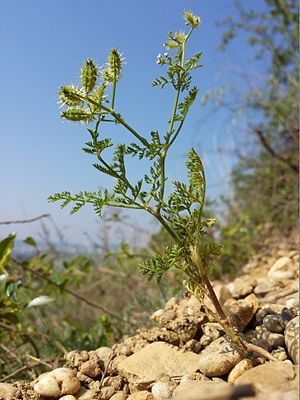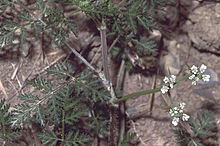Carrot clasp
| Carrot clasp | ||||||||||||
|---|---|---|---|---|---|---|---|---|---|---|---|---|

Carrot umbel ( Caucalis platycarpos ) |
||||||||||||
| Systematics | ||||||||||||
|
||||||||||||
| Scientific name | ||||||||||||
| Caucalis platycarpos | ||||||||||||
| L. |
The carrot-stick umbel ( Caucalis platycarpos ), also called arable-stick umbel , is a plant species within the umbelliferae family (Apiaceae).
description
Vegetative characteristics
The carrot-cupped umbel grows as a deciduous, annual herbaceous plant that reaches stature heights of 10 to 30, rarely up to 40 centimeters. The stem is sparsely branched, more or less gray-green in color and scattered hairy to bald. Often only the leaf hachis is hairy with loosely bristles. The leaves are two to three times pinnate and have narrow, about 0.5 millimeter wide end sections.
Generative characteristics
The double-gold inflorescence is two to three, rarely up to five-rayed and have no or up to two bracts. The döldchen are equipped with three to five husk leaves that are hardly skin-edged. There are three short-stalked hermaphroditic flowers and three long-stalked male flowers in the arm-flowered little bulbs. The crown is white to pink in color.
The elongated, about 6 to 13 millimeter long double achees and in the variety Caucalis platycarpos var. Platycarpos have 1 to 2 millimeters long, hooked spines at the tip. In the case of the variety Caucalis platycarpos var. Muricata , these spines are shorter than 1 millimeter and without barbs at the tip.
Phenology
The flowering period extends from May to July, occasionally until autumn.
Chromosome number
The number of chromosomes is 2n = 20.
ecology
The carrot stick umbel is a therophyte .
In addition to insect pollination , self-pollination also occurs.
The barbed fruits are subject to Velcro and step spread. The strong traction of these Velcro fruits can also be an obstacle to their spread.
Occurrence and endangerment
The original distribution area of the carrot-stick umbel includes Portugal, Spain, France, Italy, Central Europe, Denmark, Slovenia, the Balkan Peninsula, Bulgaria, Romania, Ukraine, Estonia, Latvia, Moldova, Slovakia, Hungary, Turkey, Syria, Cyprus, Lebanon, Iraq , Iran, Afghanistan, Armenia, Azerbaijan, Georgia, the Caucasus and Kyrgyzstan. In Central Europe, the carrot-stick umbel is an archaeophyte that has immigrated in the wake of humans and occurs mainly in the limestone and warm regions. In Baden-Württemberg it is documented by fossil finds from the 12th century. Occurrences in port and railroad facilities and in grain silos indicate recent introductions. The eastern Mediterranean is believed to be the original home.
The carrot umbel grows individually or in loose stocks in grain fields (especially spring wheat) as well as on roadsides and on fallow land in light-rich, moderately dry, lime-rich, often skeletal , alkaline areas. It is considered a tone pointer. It occurs on the edges of fields and in the corners of fields, mostly it prefers low-growth to open areas. Occasionally it also appears on heaps of rubble. It is the eponymous character species of the association Caucalidion lappulae and the association Caucalido lappulae-Adonidetum flammeae.
The carrot-sticking umbel was still widespread in the lime and warm areas of Central Europe after the Second World War. Since then it has declined sharply and has completely disappeared in many regions or has been pushed back to small populations, mostly on the edge of the field. The reason for this decline is the intensive fertilization of the fields (and the associated lack of open spaces). The use of herbicides is likely to be a major problem for the carrot-sticking umbel.
In Germany, the carrot-stick umbel is rated as endangered with a stronger regional threat (category 3+). In Austria, the variety Caucalis platycarpos var. Platycarpos is considered endangered, the variety Caucalis platycarpos var. Muricata as critically endangered. In Switzerland this species is classified as vulnerable.
Systematics
Caucalis platycarpos was first published by Carl von Linné in his work Species Plantarum in 1753 . Synonyms for Caucalis platycarpos L. are Caucalis lappula Grande and Caucalis daucoides L. non L. 1753 .
Depending on the author, there are two varieties that are often considered as subspecies :
- Caucalis platycarpos L. var. Platycarpos
- Caucalis platycarpos var. Muricata (Godr.) VNTikhom. (Syn .: Caucalis platycarpos subsp. Muricata (Godr.) Holub , Caucalis bischoffii Koso-Pol. , Caucalis muricata Bisch. Non Crantz )
Common names
The common name Strigelen is also used for Württemberg .
swell
literature
- Henning Haeupler, Thomas Muer: picture atlas of the fern and flowering plants of Germany . Ed .: Federal Agency for Nature Conservation (= The fern and flowering plants of Germany . Volume 2 ). Eugen Ulmer, Stuttgart (Hohenheim) 2000, ISBN 3-8001-3364-4 , pp. 366 .
- Oskar Sebald, Siegmund Seybold, Georg Philippi (Hrsg.): The fern and flowering plants of Baden-Württemberg . tape 4 : Special part (Spermatophyta, subclass Rosidae): Haloragaceae to Apiaceae . Eugen Ulmer, Stuttgart (Hohenheim) 1992, ISBN 3-8001-3315-6 , pp. 252-254 .
- Wolfgang Adler, Karl Oswald, Raimund Fischer: Excursion flora of Austria . Ed .: Manfred A. Fischer. Eugen Ulmer, Stuttgart / Vienna 1994, ISBN 3-8001-3461-6 , p. 563 .
- Christian Heitz: School and excursion flora for Switzerland. Taking into account the border areas. Identification book for wild growing vascular plants . Founded by August Binz. 18th completely revised and expanded edition. Schwabe & Co., Basel 1986, ISBN 3-7965-0832-4 .
- Erich Oberdorfer : Plant-sociological excursion flora . With the collaboration of Theo Müller. 6th, revised and expanded edition. Eugen Ulmer, Stuttgart (Hohenheim) 1990, ISBN 3-8001-3454-3 , pp. 704 .
Individual evidence
- ↑ a b c d Caucalis platycarpos L., Acker-Haftdolde. In: FloraWeb.de.
- ↑ a b c d e f g Erich Oberdorfer : Plant sociological excursion flora . With the collaboration of Theo Müller. 6th, revised and expanded edition. Eugen Ulmer, Stuttgart (Hohenheim) 1990, ISBN 3-8001-3454-3 , pp. 704 .
- ↑ a b c d e f g h i j k l m Oskar Sebald, Siegmund Seybold, Georg Philippi (eds.): The fern and flowering plants of Baden-Württemberg . tape 4 : Special part (Spermatophyta, subclass Rosidae): Haloragaceae to Apiaceae . Eugen Ulmer, Stuttgart (Hohenheim) 1992, ISBN 3-8001-3315-6 , pp. 252-254 .
- ↑ a b c d e Manfred A. Fischer, Karl Oswald, Wolfgang Adler: Excursions flora for Austria, Liechtenstein and South Tyrol . 3rd, improved edition. Province of Upper Austria, Biology Center of the Upper Austrian State Museums, Linz 2008, ISBN 978-3-85474-187-9 , p. 840 .
- ↑ a b c d e f Gustav Hegi: Illustrated flora of Central Europe. Pteridophyta, Spermatophyta . 2nd Edition. Volume V. Part 2: Angiospermae: Dicotyledones 3 (2) (Cactaceae - Cornaceae) . Carl Hanser and Paul Parey, Munich and Berlin / Hamburg 1966, ISBN 3-489-74021-1 , p. 1062–1064, 1566 (unchanged reprint from 1926 with addendum).
- ↑ a b Ruprecht Düll , Herfried Kutzelnigg : Pocket dictionary of the plants of Germany and neighboring countries. The most common Central European species in portrait . 7th, corrected and enlarged edition. Quelle & Meyer, Wiebelsheim 2011, ISBN 978-3-494-01424-1 , p. 787 .
- ^ Caucalis in the Germplasm Resources Information Network (GRIN), USDA , ARS , National Genetic Resources Program. National Germplasm Resources Laboratory, Beltsville, Maryland. Retrieved May 18, 2018.
- ↑ Caucalis platycarpos. In: Info Flora (the national data and information center for Swiss flora).
- ↑ Carl von Linné: Species Plantarum. Volume 1, Lars Salvius, Stockholm 1753, p. 241, digitized
- ↑ Jean-Pierre Reduron: Ombellifères de France 2. In: Bulletin de la Société Botanique du Center Ouest, Nouvelle Série. Numéro Spécial. Volume 27, 2007, Caucalis, pp. 750-767.
- ^ Georg August Pritzel , Carl Jessen : The German folk names of plants. New contribution to the German linguistic treasure. Philipp Cohen, Hannover 1882, page 85. ( online ).
Web links
- Profile and distribution map for Bavaria . In: Botanical Information Hub of Bavaria .
- Carrot clasp . In: BiolFlor, the database of biological-ecological characteristics of the flora of Germany.
- Caucalis platycarpos L. In: Info Flora , the national data and information center for Swiss flora . Retrieved January 2, 2016.
- Data sheet and pictures at Blumen in Swabia






